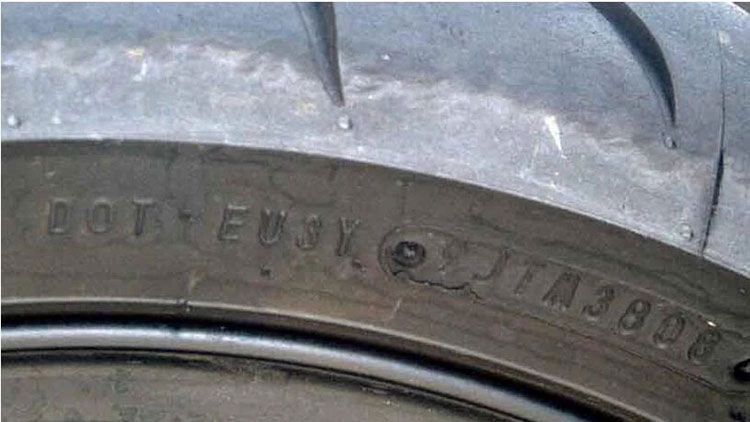Everything You Wanted to Know About Motorcycle Tires. From radial tp bias, tire dating, tire pressure and tire selection, it is all right here.
Curious about those round rubber things attached to your wheels? We have some answers for you
Motorcycle tires are more than just simple black rubber hoops that keep your wheels from grinding against the trail or road surface. These are state of the art traction providing technology that continues to get better every year, even though the basic concept remains the same as it always has. Tires work so well by providing a cushion of air between your machine and the ground, which give tire its shape, allows them to conform to the surfaces and soak up bumps.
This basic design has remained in use throughout the world for more than a century. Originally, tires were made from natural rubber, and these days virtually all tires today are made from synthetic rubber which is a blend of petroleum, along with chemicals such as sulfur, carbon black and silicone. Tires are built up in stages, starting with the assembly of the cord and belting structure, and after that, rubber is applied and molded, then vulcanized with extreme heat to join it all together and prepare them for use on our favorite motorcycle.
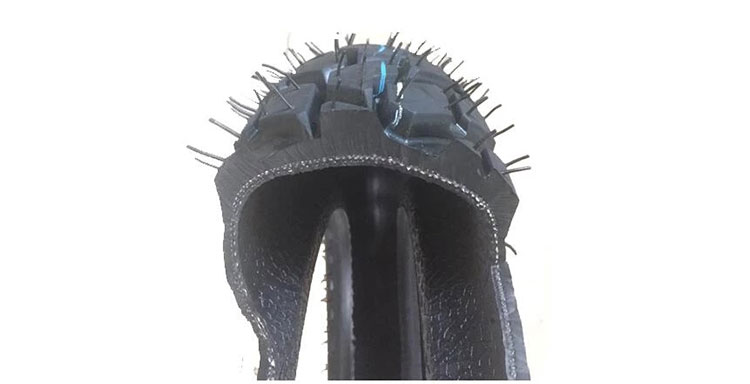
What Motorcycle Tires Do
Tires not only provide traction for accelerating, braking and turning, but also serve as a part of the suspension. Like I mentioned earlier, the tires soak-up the first part of the impact from bumps, before the fork and shock even begin to work. They are also called upon to perform well in a wide variety of conditions, including extreme heat, cold, and wet.
You actually bet your life on your tires, so aren't they worth taking a little time and attention for their care and condition? Pay close attention to what your tires are telling you while you're riding. If steering seems odd or mushy, or if cornering and braking response feels heavy, there's a good chance your tires are underinflated. Vibration or wobble may also signal that a leak or tire damage has occurred and failure is imminent.

Different Types of Motorcycle Tires
The two primary types of tires are radial and bias. Within the bias category are regular bias and bias belted tires. The bias belted have a more robust construction. The terms Radial and Bias refer to how the internal cords and belts are arranged during the construction of the tire. Essentially, radial belts go straight across the tread at a 90-degree angle from side to side, whereas bias construction has the belts going diagonally across the tread area. This makes for different dynamic characteristics which greatly affect handing, wear, braking and rolling resistance between radials and bias tires.
Radial tires are a newer design and are widely used on current model motorcycles, while bias tires are used mainly on some cruisers and older motorcycles. In general, radial tires run cooler (leading to longer life), have stiffer construction (which makes them feel more responsive), and feature sidewalls with a lower aspect ratio, resulting in less flexi. Bias-ply tires generally offer a softer, more compliant ride and, typically, a little lower price. Their other main advantage is load-carrying capability. In a given size, you’ll often see a bias rated to handle more weight.
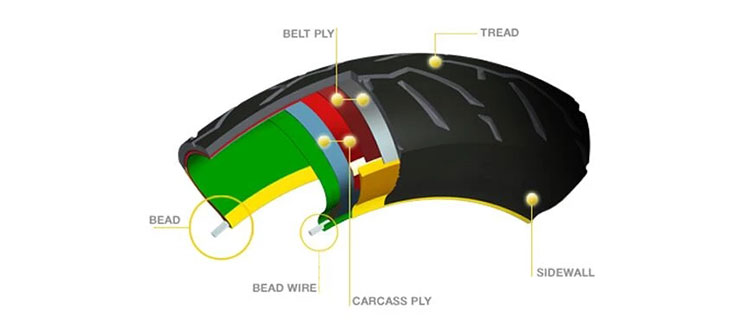
It is never a good idea to mix the two types on a motorcycle, as it can adversely affect handling and may lead to a crash. Before switching a motorcycle from bias to radial tires, check with your dealer or the tire manufacturer for advice regarding if and how this works out on the specific model. Some folks also have been known to use automobile tires on motorcycles, often because they are cheaper, or last longer. The construction, compounds and profiles of these tires are generally not suited to motorcycle use, and they should be avoided. There is a caveat to the idea of running a bias-radial combination. There are actually modern bikes running this combo so there are instances when it works. But as a general rule, it should not happen unless it came that way from the factory.
Different materials are used in the construction of various types of tires. Many premium tires are made with steel belts, which are stronger than the synthetic fabric cord materials, such as nylon and rayon. Since these different materials have distinct ride and handling properties, tires with different construction or materials should not be mixed on the same motorcycle.
Tire Tread is a Compromise so Choose Wisely
There are also many types of tread designs and patterns. It's important to select the right tires for your bike and riding style. Each type of tire is a compromise, so choose carefully. Generally, tires with large knobby treads are best in loose dirt and off-road use, and tend to squirm a lot and wear quickly on pavement. They also don't have good grip on hard paved surfaces.
Many dual sport and adventure bikes are fitted with less aggressive open tread patterns which tend to be somewhat better on pavement and wear better, but they sacrifice traction in loose dirt, sand and mud. Dual-purpose tires often are sold with a designation such as 50/50 or 90/10, indicating the percentages of traction on pavement vs. dirt. Be realistic with what you plan to actually do, as being wrong in either direction will likely make you unhappy with your choice. Tires used on the street should always have a DOT approval molded into the sidewall.
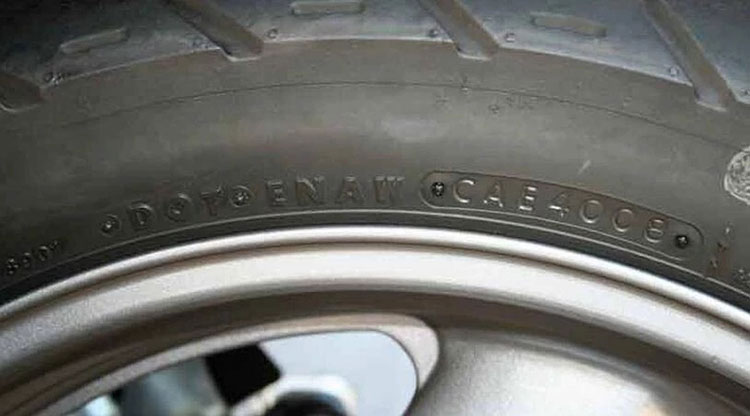
Street tires generally have a much less-aggressive tread pattern than tires used off-road. Street tires will always have rain grooves to channel water away from the center of the tire in an effort to improve grip and prevent hydroplaning in the wet. Sportbike tires which are designed for use on dry roads and race tracks have fewer rain grooves and therefore sacrifice grip in wet situations. The less grooves, typically results in more surface and a potentially slight increase in traction. Avoid using slicks on the street, which are designed for race tracks and have no grooves, as they are illegal and can be dangerous on roads where there are wet patches, puddles, etc. Tires also come in various rubber compounds, which are blended to provide vastly different properties. Generally, tires with softer high-grip rubber tend to wear out faster than tires with harder compounds, so it's important to understand what a particular tire is designed for before purchasing it.
How to Check Them
Tire pressures should be checked frequently. Technically, you should check your tire pressure every time before you begin to ride. There are several reasons for that. Tire pressures are supposed to be checked cold, at ambient temperature. As soon as you begin to ride the tires warm up from flexing and contact with the road, and the internal pressure rises. This results in getting a false inaccurate reading if you stop to check pressure, mid-ride at a gas station, for example.
There's also the obvious safety reason. If a tire has picked-up a nail or otherwise is losing pressure, it could cause a crash on the way to the gas station, where you were planning to check tires. We recommend that you find a place on your bike (or carry it in your pocket if there's no place on the bike) for a tire pressure gauge. Get a good quality gauge, cheap ones tend to be inaccurate.
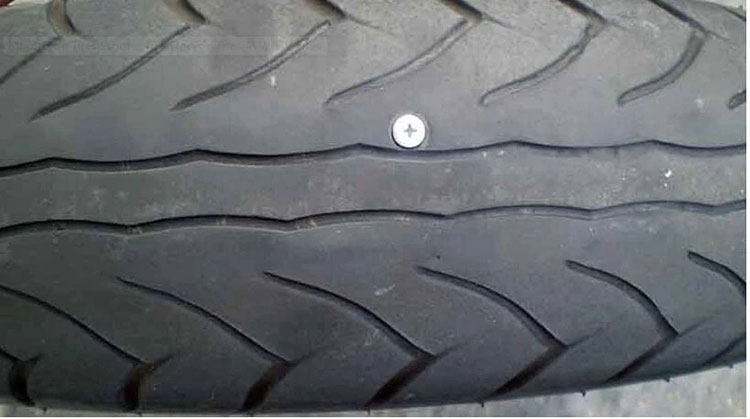
Look up the recommended tire pressure in the bike's owner's manual. Note that many models have different specifications not only for front and rear, but also for low speed and high speed operation, along with light (solo) and heavy loads, plus passengers. Don't use the pressure shown on the tire sidewall, unless the bike is at full load, because the sidewall pressures shown are maximum pressures.
Replacing Your Tires
Eventually tires wear out, and need replaced. Typically the rear tires start to square up, losing their rounded profile, as the center of the tread wears away faster than the shoulders. Front tires generally wear more evenly across their tread, but may begin to develop scalloped wear known as cupping. Knobby tires are more obvious as the knobs start to wear, tear or break-off over time.
Inspect your tires for adequate tread depth. When the tire is worn to the built-in indicators at 1/32nd inch (0.8 millimeters) or less tread groove depth, or the tire cord or fabric is exposed, the tire is dangerously worn and must be replaced immediately. Also inspect tires for uneven wear. Wear on one side of the tread, or flat spots in the tread may indicate a problem with the tire or bike. Consult your local dealer or mechanic for help. Inspect your rims also. If you have a bent or cracked rim, it must be replaced.
A good practice is to plan ahead and have replacement tires lined up and ready to install before the old ones are totally worn out. Tubes should be replaced at the same time as the tires, on tube types. Old tubes deteriorate and are prone to cracking, which can lead to sudden failure, so a new tube should be installed whenever the tire is replaced. Make sure the tube (if it is used) is the right size and is compatible with radials if need be. Rim strips should also be replaced if they look deteriorated.
On tubeless tires, it's also a good practice to replace the valve assemblies, as the rubber deteriorates. Tire pressure monitoring system sending units in the wheels of some high-end, modern bikes should also be checked and their batteries replaced as needed.
Tire Markings Explained
Older model motorcycles often came with inch-denominated tire sizes, such as a 3.25 x 19 front and a 4.00 x 18 rear. The first number is the tire width in inches (3.25 meaning 3 ¼ inch) and the last number indicates the rim diameter at the bead mounting surface, in inches. Most modern motorcycles use a mixture of metric and inch sizing. With these, the first number indicates the section width in millimeters, the second number indicates the aspect ratio expressed as a percentage, and the last number is the rim diameter in inches. For example, with a 120/60-ZR17 the 120 is the width, the 60 is the aspect ratio, the Z is the speed rating and the R indicates radial.
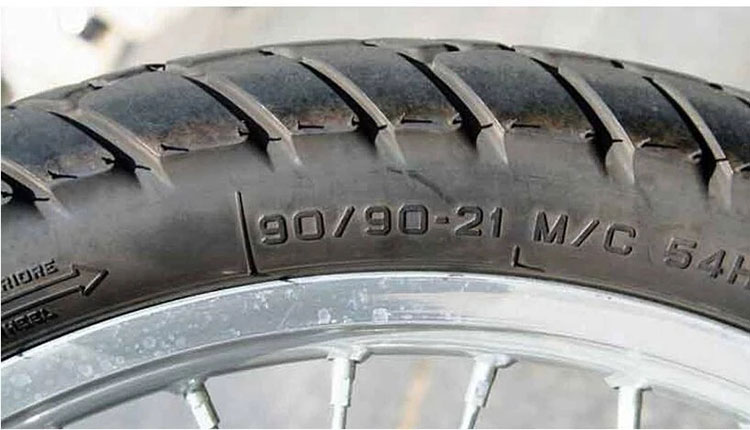
Another tire sizing method is the alphanumeric system. These are often found on cruiser tires. Every alphanumeric motorcycle tire will start with an “M.” For example, with an MT90-16 the T indicates the width (which is 130mm, the 90 represents the aspect ratio (aspect ratio is height of the sidewall expressed as a percentage of the tire's width) and the wheel diameter (16) is shown in inches. With a radial, there would be a letter “R” between aspect ratio and rim size. Since there is none, this is a bias-ply tire. Were this a bias-belted tire (with additional, stiffening layers over body plies), a letter “B” would be between the aspect ratio and wheel size. Tire width charts are widely available in tire catalogs and online if you need them, but stick with what you have.
Load Ratings
Some motorcycle tires are available in a choice of load ratings for a given size. Typically this is the case with rear tires for some of the larger sport-touring machines. Make sure you choose the right tire for your bike, load and use. Replace your tires with ones that have a load rating at least as high as the old ones for safety.
Tire Dating Explained
Sorry, there is no such thing as TiresOnly.com so if you are a single tire, you might want to try Craigslist Personals… Of course, we’re kidding! When tires are manufactured they have a date stamped into the sidewall. This code is a four-digit number following “DOT” on the sidewall. The first two digits indicate the week the tire was made, and the last two digits indicate the year. For example, 0414 would indicate the fourth week of 2014.
This is important because tires harden and the rubber deteriorates over time, even faster when tires are left out in the sun and weather. Most manufacturers recommend that tires be replaced when they are about six years old. However, tires should also be replaced if any significant sidewall cracks form, even if that is sooner.
Tires and/or bikes should also be stored indoors in a cool, dry place where water cannot collect on the important components and they are protected from the sun. Tires should be stored away from electric generators and motors (because ozone damages rubber) and sources of heat such as hot pipes.
In order for new tires to provide optimum performance, they should be ridden cautiously for about the first 100 miles in order for the tread surface to be “scuffed-In” and work properly. Immediately after new tires are mounted, sudden acceleration, maximum braking, and hard cornering should be avoided. This will allow the rider to adjust to the feel and handling characteristics of the new tire and for the new tire to be “scuffed-In” correctly in order to achieve optimum grip level. Track riders will scoff at this notion, but we are making this recommendation that you err on the side of caution.
As you can see, tires are more than just round loops of rubber. Not only are they the connection between your motorcycle and the road but they are the difference between having a great day riding and a day you would not soon forget. Take care of your tires and choose your tires styles wisely and if possible, don’t skimp on them. Usually, you get what you pay for.






